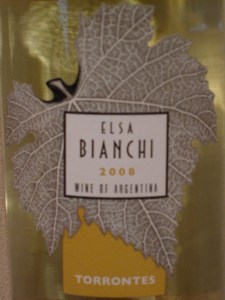There was absolutely no question that this week’s CorkPopper recipe had to involve fresh pasta. Even more than the famous Argentinian beef, J and I fell in love with the delicate, handmade pasta we found at so many of the restaurants we visited, especially the ravioli (which they sometimes call sorrentini).
Argentina, you see, experienced a large influx of Italian immigrants in the 19th and 20th centuries, and (at least according to Wikipedia) around 60% of Argentina’s population have some degree of Italian descent. What this means, of course, is not only delicious pasta and ice cream but also that yours truly, a non-Spanish speaker who once lived in Italy, actually understood the Argentine Spanish accent better than some Spanish-speakers do at first. Ha!
So, back in Los Angeles and in need of a recipe for this week’s CorkPopper dinner, J and I came up with the following recipe for crab and ricotta ravioli with a light cream sauce. The sweetness of the crab and delicate flavor of the ricotta are sure to pair nicely with the Dona Paula Tupungato Sauvignon Blanc, and the cream sauce lends just enough weight to make the dish satisfying and comforting on a nice January evening. Yummmmm…..
Crab and Ricotta Ravioli with Cream Sauce
Serves 4
Ingredients for Ravioli
2 cups flour
1/2 pound lump crab meat
1 cup ricotta cheese
3 large shallots, minced
Extra virgin olive oil
Freshly ground pepper
Sea salt
Ingredients for Cream Sauce
 2 1/2 cups heavy cream*
2 1/2 cups heavy cream*
1/2 cup fresh lemon juice
12 tablespoons unsalted butter**
2 cups Parmiggiano, grated
2 teaspoons finely grated lemon zest
A pinch of nutmeg
Sea salt and freshly ground pepper
Preparation
Put about 2 cups all-purpose flour in a bowl. Slowly add ice cold water, combining thoroughly before adding more. Once you’ve got a dough-like substance that is soft but not mushy, stop adding water. Roll it into a ball, put it back in the bowl, cover with a towel, and place it in the fridge to set for at least 30 minutes.
While the dough is chilling, heat about a tablespoon of extra virgin olive oil over medium-high heat. Add the shallots and saute until translucent. Remove from heat and allow to cool.
 Dry the crab meat of any excess liquid. Make the ravioli filling by combining the crab meat and ricotta, breaking up any extra large pieces of crab as necessary. Add the shallots and season with salt and pepper to taste. Cover and refrigerate until you’re ready to assemble your ravioli.
Dry the crab meat of any excess liquid. Make the ravioli filling by combining the crab meat and ricotta, breaking up any extra large pieces of crab as necessary. Add the shallots and season with salt and pepper to taste. Cover and refrigerate until you’re ready to assemble your ravioli.
Heat a large pot of salted water. Take a palm-sized amount of dough and roll it out to about 1/8 inch thick. I use a pasta roller, but you should be able to accomplish this with a rolling pin as well. Dust your surface with flour so that the dough doesn’t stick. Place a small dollop of the filling a few inches from the edge of the rolled-out dough. Fold the dough over the filling, taking care to not trap any air inside (it will explode in the water if there are air pockets). Press the edges together with your fingers and cut the dough with a knife or a ravioli cutter.
Once you’ve made all the ravioli, place them gently in the boiling water. Make sure you’ve turned the heat down so that the water isn’t actually in a rolling boil. Once the ravioli rise to the top, they’re done.

While the pasta is cooking, stir 2 cups of the cream and the lemon juice in a heavy large skillet over medium heat to blend. Add the butter and cook over medium heat just until the butter melts, stirring occasionally, about 3 minutes. Remove from the heat. Add the remaining cream and the Parmiggiano to the sauce along with the zest, nutmeg, salt and pepper. Stir over low heat until the sauce thickens slightly, about 1-2 minutes.
As the ravioli finish cooking, gently remove them from the water with a slotted spoon and add them to the sauce to coat. Transfer to pasta bowls or deep plates and garnish with fresh basil leaves and lemon zest for color. Serve with crusty grilled bread (duh) and a colorful salad.
Cheers and buon appetito!!
Laurel
* For best results, allow the cream to come to room temperature. It will be less likely to curdle when cooked.
** As with the cream, allow the butter to come to room temperature.


























